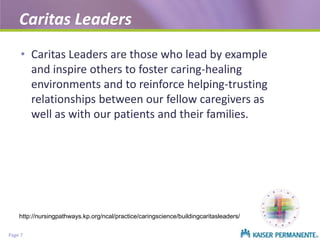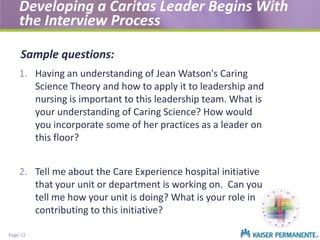Co-Creating a Sustainable Caring-Centric Leadership Paradigm
- 1. Kaiser Permanente, Northern California Caritas Consortium 2013 Co-creating a Sustainable Caring-Centric Leadership Paradigm Caritas in Action How Caring Science informs and inspires KP caregivers and affirms our commitment to provide our patients and their families exceptional care
- 2. Co-Creating a Sustainable Caring-Centric Leadership Paradigm Intent to Contribute Statement: Intentional leadership with focus on building and sculpting a new leadership team for Adult Services with focus on caring, confident, consistent, and effective leadership to serve our adult inpatient population. The Employee Choice program has been a great catalyst to move this work forward. Utilizing Caritas in Action coupled Heart Math, and other leadership development and design tools I am creating a new leadership team … growing and serving our patients and keeping pace with the changing health care environment. This work will change our patient experience from good to exceptional. The caregiver team will experience a new connection to their art in delivering care. This will be the model for caring practices in our new facility in San Leandro. As this work occurs all who are involved with experience personal and professional change. Page 2
- 3. Co-Creating a Sustainable Caring-Centric Leadership Paradigm Inspired Contributor(s) 1 : Shirley Paulson -----Service Area: GSAA Medical Center: HAY Affiliation: PCS -----Year Shared: 2013 Venue: Caritas Consortium Format: PowerPoint ID #: n/a Page 3 Keyword TAGs: Identifier Consortium2013-July, GSAA, Hayward, Podium, Patient Care Services Caritas Leadership, Team Descriptor Mentoring
- 4. Page 4
- 5. Need for New Leadership Paradigm • Through Employee Choice and promotions /changes in roles, 58% turnover of experienced managers in PCS • Hired three PCS Nurse Managers ICU/TCU 3rd floor Med/Surg/Tele 4th floor Med/Surg/Tele/Oncology • Hired seven PCS Assistant Nurse Managers (ANMs) • MCH had newly hired two ANMs Page 5 had two additional new ANMs
- 6. Flourishing through Caring Science Caritas Process #4: • Develop helping – trusting- caring relationships Caritas Process # 7: • Share teaching and learning that addresses the individual needs and comprehension styles Caritas Process #10 • Open to mystery and Allow miracles to enter Page 6
- 7. Caritas Leaders • Caritas Leaders are those who lead by example and inspire others to foster caring-healing environments and to reinforce helping-trusting relationships between our fellow caregivers as well as with our patients and their families. http://nursingpathways.kp.org/ncal/practice/caringscience/buildingcaritasleaders/ Page 7
- 8. Guiding Inquiry for Caritas Leaders • What does it mean to Lead with Care? • How do I communicate authentically and express my values and beliefs every day? • How do I align my actions and my words? • How do I align mind-body-spirit and co-create a healing environment http://nursingpathways.kp.org/ncal/practice/caringscience/buildingcaritasleaders/Caritas%20Leader s%20-%20Guiding%20Inquiry.pdf Page 8
- 9. New Leadership Paradigm to Develop Caritas Leaders Must Haves: • It was critical to develop a Leadership program that had a new way of thinking— Values Based, integrated in every day experiences • This needed to start at the Interview process • This program needed to incorporate Caritas and HeartMath principles • Needed didactic as well as practical applications • Needed Mentoring component Structured process with Learning Objectives, meetings Mentor / Mentee Orientation Page 9 Matched an Experienced Leader Mentor with the new Mentee Learning Objectives as part of Individual Development Plan
- 10. Traditional vs Values Based Leadership The Traditional 20th-Century Leader: "Driving" Change The Values-Based Leader: Cultivating Healthy Change with Leadership Intelligence and Caring Science “Top Down” Culture of Fear and Reprisal Metric-Driven vs Value-Driven Tim Porter O’Grady: Creating the Culture for Practice Accountability in Value-Driven Healthcare Focus on Financial Objectives in and of themselves Values-based Caritas leaders focus primarily on trusting, timeless human values and caring relationships as ends in themselves. Quality will follow if you “do the right thing” Traditional leaders manage others through rules, rewards, and punishments, reducing employee commitment A values-based Caritas leader is open to shared learnings and helps others to lead themselves so that each group can make key decisions, using Caring Science inquiry Traditional leaders make decisions issued as directives, orders and policies. Then followers are expected to carry out the decisions, often without questions or verbal feedback from workers. A values-based Caritas leader encourages group intelligence by giving each group the power to provide input and feedback on organizational decisions. Leaders who embrace altruistic values and shared decision making start to emerge everywhere. Page 10
- 11. Leader Orientation • Managers are in a position to influence, impact and shape staff’s experiences • This program is intended: To develop new managers into extraordinary Caritas leaders and, To provide a strong foundation to Learn and Lead in a safe environment Page 11
- 12. Developing a Caritas Leader Begins With the Interview Process Sample questions: 1. Having an understanding of Jean Watson's Caring Science Theory and how to apply it to leadership and nursing is important to this leadership team. What is your understanding of Caring Science? How would you incorporate some of her practices as a leader on this floor? 2. Tell me about the Care Experience hospital initiative that your unit or department is working on. Can you tell me how your unit is doing? What is your role in contributing to this initiative? Page 12
- 13. Kaiser Permanente – Existing Leadership Development Programs New Manager Orientation • 2-day Facilitated (Instructor-Led/Classroom course. Part of STAR Leadership Curriculum for New Managers STAR Leadership (Steps to Achieving Results) EFM Essentials for Managers • 15-20 minute Web-Based Lessons • Developed to provide tools to help new managers build their understanding of KP NCAL’s organizational strategy of quality, service at a competitive price. IMPACT Leadership NCAL Page 13 • A series of in- facilitated and web-based courses with defined curriculum for First 180-days and 2nd 180-days through 1year. Elective courses are also identified. • STAR is designed for those who are new to leadership roles as well as those who are seasoned professionals. • Web-Based and Classroom Training, Harvard ManageMentor • Curriculum divided into the following categories: Foundational Courses (New Managers (0-2 yrs), Performance Leadership (Frontline Dept. Managers and Stewards) , Executing Strategy (Middle Managers) and Advanced Courses
- 14. A New Paradigm If we agree that caring is central to nursing, are we ready to embrace a paradigm that properly acknowledges its significance in our work and provides the necessary direction for manifesting a bright and confident future? Page 14
- 15. Nursing Leader Orientation New Orientation Checklist Alignment of STAR leadership courses with weekly Management meetings Weekly Educational focus with guest speakers to reinforce didactic Monthly calendar Caring Science Leadership refresher training Mentoring program: Each Mentee is matched to a Mentor, based on the initial Questionnaire and preference checklist completed by the Mentee 14 Mentees matched to 13 Mentors (one Mentor had two Mentees) Page 15
- 16. New Manager Orientation Calendar Weekly focus integrates didactic with practicum New Orientation Checklist First 90 day Mentoring Program
- 17. Mentoring Program Objective • It is our goal to offer guidance, support and expertise from a “matched” Mentor Leader within the GSAA for new Assistant Nurse Manager and Nurse Managers Mentees in the Adult and MCH Patient Care Services through a structured, 90-day Mentoring program. • At the end of this 90 day mentoring period, all Mentees will accomplish at least two of the three Learning Objectives identified in the initial Mentor/Mentee Learning Agreement. Page 17
- 18. What is Mentoring? • Mentoring is a powerful personal development and empowerment tool which can be an effective way of helping staff to develop in their careers • Should be viewed as a safe, non-judgmental relationship • Facilitates learning, experimentation and development • Mentors selected were accomplished Leaders within GSAA without a direct reporting relationship to Mentee • Mentors have roles outside of PCS: Page 18 AR&L Director, Hayward PI Director, Hayward PI Director, Fremont Care Experience Director GSAA Area Quality Leader, Hayward Director of STAR Leadership Director, Maternal Child Health - Transition Leader for San Leandro - Perioperative Services Director, GSAA - Administrative Services Director, GSAA - Director of Public Affairs, GSAA - Director of Education and Clinical Informatics, GSAA - Director, Adult Patient Care Services
- 19. What is Mentoring? • Mentoring is a voluntary and supportive relationship whereby a more experienced staff shares their knowledge, skills and experience to guide others to progress in their own lives and careers • “Mentoring is more than ‘giving advice’, or passing on what your experience was in a particular area or situation. It's about motivating and empowering the other person to identify their own issues and goals, and helping them to find ways of resolving or reaching them not by doing it for them, or expecting them to ‘do it the way I did it’, but by understanding and respecting different ways of working” Source: http://www.admin.cam.ac.uk/offices/hr/ppd/pdp/mentoring/what/ Page 19
- 20. Mentoring Program is Mentee Driven • Mentoring program is Self-Driven, Confidential • Takes place outside of the direct reporting relationship • Mentees: Identifies their own development needs and goals Solves problems by enhancing their own self-awareness Page 20 Take responsibility and ownership for their own learning and development Meeting agenda development is Mentee-driven
- 21. Mentor supports Self Discovery • Mentor acts as a conduit to self discovery and reflection, and gives the Mentee the space and time to make their own decisions Page 21
- 22. What is a Mentor? Sounding Board to test ideas and suggestions Facilitator to be able to point to potential opportunities, arrange introductions Advisor to provide objective advice on a range of issues, including career opportunities Coach to directly assist the mentee to improve a specific skill Source: https://www.dur.ac.uk/hr/mentoring/mentoringguidelines/whatismentoring/ Page 22
- 23. Mentors can serve as a… Expert to act as a source of technical/professional knowledge Source of to be able to explain Kaiser policies, organizational material culture, values Role model to promote and encourage positive behaviors in others Source of feedback to provide constructive feedback Confidant to express fears and concerns to Motivator to encourage the achievement of goals and boost morale Challenger to challenge assumptions and encourage alternative thinking Page 23
- 24. Meeting Requirements • Initial one hour meeting Initiate discussion about your learning objectives Mentee to email your Learning Objectives to your Mentor after your first meeting, cc copy to Shirley Paulson (Program Coordinator) Develop Mentee/Mentor Agreement, cc to Shirley Paulson • Weekly check-in 5”-15” or so via phone or email • At least one hour per month face to face meeting (can be two 30 minute meetings each month) • Prior to your last meeting with your mentor, review your learning objectives and reflect on what you have accomplished Page 24
- 25. Mentoring Process • Mentor/Mentee Agreement Meeting Logistics: how, when Confidentiality • Learning Objectives Agreement Make it a SMART objective Page 25 Define 3 learning objectives you want to accomplish Mentee to add Learning Objectives to Individual Development Plan (IDP) in Total Performance
- 26. Mentee Application & Preference List Page 26
- 27. Mentee Application (a closer view) Page 27
- 29. Summary • Creating a sustainable, Caring-Centric leadership program takes a village • Set Expectations that Leadership is Value-Based and behaviors support a trusting staff / manager relationship • It is a shared experience ; we learn from each other • Caritas is incorporated in what we do, everyday • Be open to “Mystery”—take joy in each day, celebrate the successes Page 29
- 30. Acknowledgements • Thanks to the following for their support: Beth Eichenberger, MCH Director Hayward Debbie Hemker, COO Hayward Evelyn Nodal, Care Experience Leader GSAA Eileen Sapinoso, DECEPI GSAA Dennis Spivack, Director STAR Leadership GSAA Page 30 Joanne Mette, CNO GSAA Genevieve Wright, ASD GSAA






























